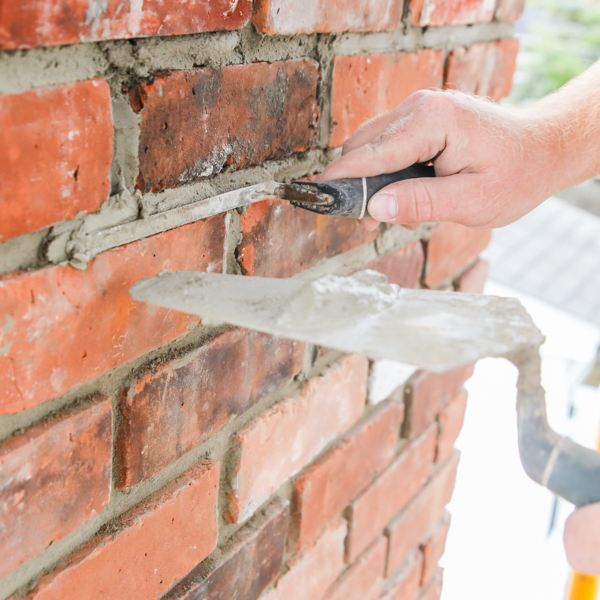Unlocking the Keys of Sustainable Masonry Building And Construction Practices for Eco-Friendly Structures
In the world of contemporary building, the pursuit of lasting practices has actually ended up being critical. Among the myriad techniques to green structure, sustainable masonry building and construction attracts attention as a time-tested and sturdy method that holds a wide range of untapped possibility. From the option of products to cutting-edge building and construction techniques, the keys to achieving sustainability within masonry building are complex and interesting. By exploring the advantages, products, techniques, and future patterns of lasting masonry, a much deeper understanding of just how these techniques can form the future of environment-friendly structures arises.
Advantages of Lasting Masonry Construction
Embracing sustainable stonework building techniques not only lowers environmental effect yet likewise provides lasting economic benefits to contractors and neighborhoods. By making use of materials like recycled bricks, blocks, and stones, builders can substantially decrease the carbon impact of their projects while advertising source performance. In addition, lasting masonry building and construction methods, such as proper insulation and thermal mass buildings, can enhance energy effectiveness within structures, causing lowered operational expenses in time.
Furthermore, the toughness and strength of masonry structures contribute to lasting financial benefits. Structures constructed utilizing sustainable masonry methods frequently need less maintenance and repair service, translating to cost financial savings for builders and residential property proprietors. The durability of masonry materials additionally makes certain that structures remain steady and protected, decreasing the need for frequent renovations or replacements.
Eco-Friendly Masonry Products
Making use of environmentally friendly stonework materials is a critical step in the direction of improving the sustainability of building and construction techniques and decreasing environmental effect while maximizing long-lasting financial benefits. Lasting masonry materials are sourced, produced, and utilized in a manner that decreases overall environmental effect. Lasting concrete obstructs include recycled accumulations and may include better insulation residential properties, adding to power efficiency in buildings.
Additionally, all-natural products like adobe, rammed planet, and straw bales give exceptional thermal mass residential or commercial properties, minimizing the requirement for heating and cooling down power. These products are typically in your area available, promoting local economies and decreasing transportation-related carbon emissions. By selecting eco-friendly stonework materials, building and construction tasks can substantially lower their environmental footprint and add to the development of healthier, more lasting developed environments.
Energy-Efficient Masonry Strategies
Power performance plays an essential role in boosting the sustainability of masonry building practices. By carrying out energy-efficient masonry strategies, building contractors can dramatically decrease the overall energy intake of a structure, resulting in lower operational costs and a smaller sized ecological footprint. One essential energy-efficient masonry strategy is the usage of thermal mass, which includes including dense products like concrete or brick into the building's framework to soak up and go to this website keep heat. This aids regulate interior temperature levels, decreasing the demand for mechanical heating and cooling down systems.

Innovations in Lasting Masonry
Recent innovations in lasting stonework techniques have brought about innovative techniques that are reshaping the building and construction sector. One such advancement is the development of self-healing concrete, which utilizes bacteria installed within the concrete to recover splits autonomously. This development not only minimizes upkeep expenses yet also enhances the resilience of stonework structures, adding to their sustainability.
Another noteworthy technology is using recycled accumulations in stonework construction - masonry contractor. By including products such as crushed ceramic waste or recycled glass right into concrete mixes, builders can decrease the ecological effect of building jobs while maintaining architectural stability. This practice not only diverts waste from landfills however also preserves all-natural sources, making it a key development in sustainable masonry building and construction
Moreover, the integration of digital residential foundation design style tools, such as Structure Details Modeling (BIM), is changing the way masonry structures are planned and constructed. BIM permits for even more specific estimations, lowered product waste, and improved power effectiveness, ultimately leading to even more lasting building techniques. These technologies jointly represent an appealing future for sustainable stonework construction in the period of eco-friendly structures.
Future Trends in Masonry Sustainability
With the innovative strides made in lasting stonework techniques, the future fads in stonework sustainability are positioned to further revolutionize the construction industry. One of the key fads shaping the future of stonework sustainability is the raised integration of modern technology. Advancements such as Building Details Modeling (BIM) and virtual reality simulations are being used to optimize masonry building processes, resulting in reduced product waste and enhanced power effectiveness in structures.
Furthermore, the development of unique lasting materials is set to play a substantial duty in boosting the eco-friendliness of stonework building and construction. masonry contractor. Technologies like self-healing concrete, recycled aggregates, and bio-based binders are acquiring traction for their capacity to decrease ecological impact while check my source preserving structural stability

Conclusion
Finally, sustainable masonry construction practices offer countless advantages for environmentally friendly structures. By using environmentally friendly materials and energy-efficient techniques, masonry can contribute to a more lasting developed atmosphere. Developments in sustainable masonry are continuously being established to additionally enhance the ecological efficiency of buildings. Looking towards the future, the pattern of stonework sustainability is expected to expand, resulting in even more eco-friendly and energy-efficient building and construction practices in the years ahead.